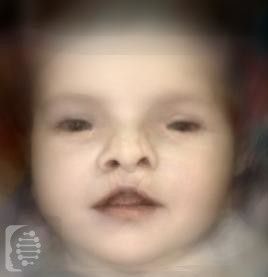What is Frontofacionasal Dysplasia?
Frontonasal dysplasia is a rare congenital malformation syndrome affecting the head, face, and eyes of affected individuals.
This syndrome is also known as:
FFND Frontofacionasal Dysostosis
What gene change causes Frontofacionasal Dysplasia?
The exact cause of gene mutations is as yet unknown. It seems to be inherited in an autosomal recessive pattern.
Autosomal recessive inheritance means an affected individual receives one copy of a mutated gene from each of their parents, giving them two copies of a mutated gene. Parents who carry only one copy of the gene mutation will not generally show any symptoms but have a 25% chance of passing the copies of the gene mutations onto each of their children.
What are the main symptoms of Frontofacionasal dysplasia?
The main symptoms of the syndrome affect the head, face, and eyes of individuals affected by it.
This includes skeletal abnormalities with the development of the skull, which leads to many of the unique facial features of the syndrome. These include a short and broad head, a cleft palate, cleft lip, an underdeveloped nose, and malformed nostrils. Dental abnormalities may also be present.
Symptoms relating to the eyes include drooping of the upper eyelid, an inability to close the eyes, and many related eye defects and symptoms.
Possible clinical traits/features:
Microphthalmia, Midline defect of the nose, Short nose, Iris coloboma, Preauricular skin tag, Autosomal recessive inheritance, Non-midline cleft lip, Bifid uvula, Blepharophimosis, Aplasia/Hypoplasia of the eyebrow, Aplasia/Hypoplasia of the corpus callosum, Aplasia/Hypoplasia involving the nose, Aplasia/Hypoplasia affecting the eye, Cataract, Brachycephaly, Ankyloblepharon, Absent inner eyelashes, Abnormality of the sense of smell, Abnormal eyelash morphology, Abnormality of calvarial morphology, Oral cleft, Eyelid coloboma, Choanal atresia, Cleft palate, Microcornea, Cranium bifidum occultum, Limbal dermoid, Encephalocele, Facial cleft, Facial asymmetry, Depressed nasal ridge, Malar flattening, Frontal cutaneous lipoma, Hypoplasia of the frontal bone, Depressed nasal bridge, Broad forehead, Short stature, Underdeveloped nasal alae, Hypertelorism, Sacrococcygeal pilonidal abnormality, Bifid nose, S-shaped palpebral fissures, Ptosis, Midface retrusion, Telecanthus.
How is it diagnosed?
To find out if someone has a diagnosis of Frontofacionasal Dysplasia, it is important to have a consultation and evaluation with a clinical genetic specialist. Specialists may also suggest specific genetic testing or other types of tests to help reach a diagnosis. FDNA’s AI technology can help speed up the diagnostic process by analyzing facial features and other health information.

